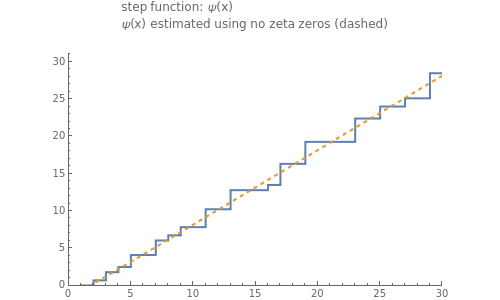Using Zeta Zeros to Compute the Chebyshev Psi Function
Using Zeta Zeros to Compute the Chebyshev Psi Function
Chebyshev's psi () function is important in number theory. It is defined as the logarithm of the least common multiple of the integers from 1 through . The graph of is an irregular step function.
ψ
x
ψ(x)
This Demonstration illustrates the remarkable fact that we can approximate the jumps of this step function by using a sum that involves zeros of the Riemann zeta function .
ζ(s)
Details
Details
Snapshot 1: the graphs of the step function and the formula using no zeta zeros
ψ(x)
Snapshot 2: the graphs of and the formula using 30 pairs of zeta zeros
ψ(x)
Snapshot 3: in order to hit the small jump in at , at least 70 zeta zeros are needed
ψ
x=128
ψ(x)
∑
p≤x
log
p
p≤x
⌊.⌋
ψ(10)=⌊(10)⌋log(2)+⌊(10)⌋log(3)+⌊(10)⌋log(5)+⌊(10)⌋log(7)
log
2
log
3
log
5
log
7
≃
⌊3.3⌋log(2)+⌊2.1⌋log(3)+⌊1.4⌋log(5)+⌊1.2⌋log(7)
=
3log(2)+2log(3)+log(5)+log(7)
= .
log(××5×7)=log(2520)
3
2
2
3
Note that 2520 is the least common multiple of the integers 1 through 10.
ψ(x)
x
x=
k
p
ψ(x)
log(p)
ψ(x)
x
ψ(x)
This Demonstration uses von Mangoldt's formula to calculate :
ψ(x)
ψ(x)≃x-(0)-2Re-
′
ζ
ζ(0)
N
∑
k=1
ρ
k
x
ρ
k
∞
∑
k=1
-2k
x
-2k
where is the complex zero of the Riemann zeta function. See[1] for general information about the function. See p. 104 of[2] for a proof of this formula.
ρ
k
th
k
ψ
′
ζ
log(2π)
x
x
∞
ψ(x)/x
x
∞
π(x)
x
log(x)
π(x)
x
The first three complex zeros of the zeta function are approximately , , and . The zeros occur in conjugate pairs, so if is a zero, then so is . The important Riemann hypothesis is the unproven conjecture that all these complex zeros have real part 1/2. So far, it has been verified that the first complex zeros do, indeed, have real part 1/2 (see[3]).
1/2+14.135i
1/2+21.022i
1/2+25.011i
a+bi
a-bi
13
10
If you use the slider to choose, say, one pair of zeta zeros, then the first sum in the above formula, in effect, combines two terms corresponding to the first conjugate pair of zeta zeros and . So, when these terms are added, their imaginary parts cancel while their real parts add. The applied to the first sum is simply an efficient way to combine the two terms for each pair of zeta zeros.
1/2+14.135i
1/2-14.135i
2Re(…)
Notice that the second sum has the same form as the first, except that the second sum extends over the so-called "trivial" zeros of the zeta function, namely, . The second sum is small when is large.
-2k=-2,-4,-6,…
x
All known zeta zeros have multiplicity 1, which is assumed in the formula. At those values of where jumps from to , the formula converges to the midpoint, , as approaches infinity. You can see this in the graphs.
x
ψ(x)
y=a
y=b
y=(a+b)/2
N
As we include more zeta zeros in the first sum, we more closely replicate the jumps in the step function . Since jumps up by at powers of the prime , this means that the zeta zeros contain information about which numbers are primes or powers of primes.
ψ(x)
ψ
log(p)
p
In Mathematica notation, can be written as psi[x_] := Sum[Floor[Log[Prime[k], x]] Log[Prime[k]], {k, 1, PrimePi[x]}].
ψ(x)
In number theory, the von Mangoldt lambda function is defined as follows: If is a power of a prime, say , where , then is defined as . For other values of , is 0. Using the von Mangoldt function, we can also write as
Λ(n)
n
k
p
k≥1
Λ(n)
log(p)
n
Λ(n)
Λ
ψ(x)
ψ(x)=Λ(n)
∑
p≤x
The von Mangoldt function was introduced in Version 7 of Mathematica. Using this function, can be written more simply as psi[x_]:= Sum[MangoldtLambda[n], {n, 1, x}].
Λ
ψ(x)
References
References
[1] Wikipedia, "Chebyshev Function."
[2] H. Davenport, Multiplicative Number Theory, 3rd ed., New York: Springer, 2000.
External Links
External Links
Permanent Citation
Permanent Citation
Robert Baillie
"Using Zeta Zeros to Compute the Chebyshev Psi Function"
http://demonstrations.wolfram.com/UsingZetaZerosToComputeTheChebyshevPsiFunction/
Wolfram Demonstrations Project
Published: March 7, 2011
